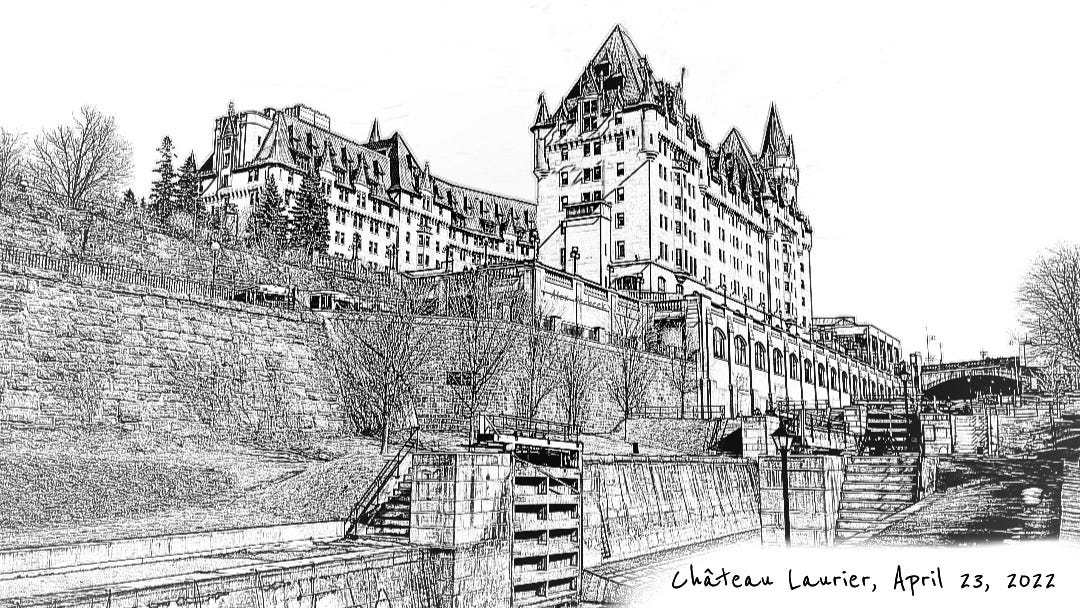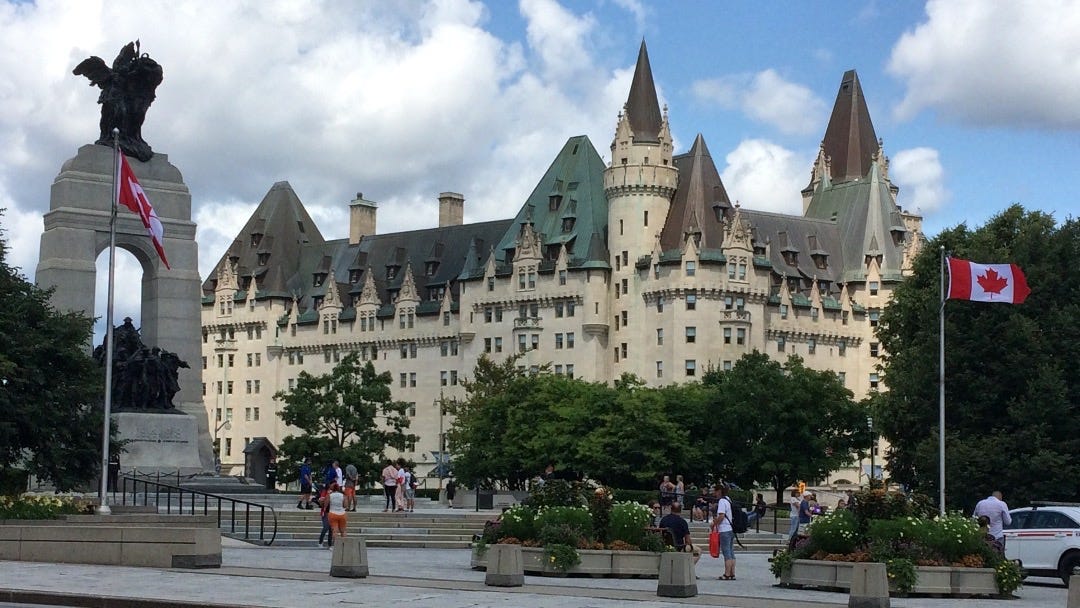Walking in Ottawa: Hotel Château Laurier
The fascinating history of the famous hotel, the Rideau Canal and the city of Ottawa
Around 1873 a 17-year-old boy, Charles Melville Hays, began working as a clerk in the Canadian railroad business. His talents were soon recognized, and he quickly rose through the ranks of management. In 1896, he became the General Manager of Canada's Grand Trunk Railway, and the company flourished under his visionary leadership.
Hays worked on his dream to create a second transcontinental railroad within the borders of Canada that ran all the way to British Columbia. In addition, he wanted company-owned tourist sites along the way to incentivize more people to use the line. Therefore, the Grand Trunk Railway started to build several magnificent hotels in the key cities where the new train made its debut.
Prophecy
In 1912 the railroad magnate said that he deplored how the steamship lines competed to win passengers with ever-faster vessels. Hays then made a prophetic comment, "The time will come soon when this trend will be checked by some appalling disaster."
Prophetic words indeed, especially while considering that he spoke these words on the RMS Titanic on the evening of the disaster. He had boarded the ship on its maiden voyage since he had to be back home in time for the official opening of the Château Laurier in Ottawa the following week; it was the latest of his splendid hotels along the railway.
The next day, Hays' body was recovered from the waters of the North Atlantic, and he was buried at Mount Royal Cemetery in Montreal. For the lovers of railway history, it may be relevant to know that the railroad car in which his body was transported back to Montreal is preserved at the Canadian Railway Museum, near Delson in Quebec.
Hays had commissioned Château Laurier while he was president of the Grand Trunk Railway. This famous hotel was built between 1909 and 1912. If the builders had taken more time, or if they had instead worked even faster to finish the work, Hays would likely have taken another ship back home from his visit to the UK, and he would have enjoyed the opening of this grand hotel.
But if he had survived the disaster, he would have witnessed how his policies ultimately ruined both the Grand Trunk Pacific Railway (GTP) and the Grand Trunk Railway in Canada. It was later alleged that Hays had deceived the company's London directors in 1903 by committing them to conditions in the railway's agreements with the Canadian government to build the GTP to which they did not agree. That scheme was blamed for the company's collapse.
French Renaissance style
But Hays would have loved to see the hotel that he had commissioned; it was one of the finest places in Ottawa. I found this description on the internet: "The hotel features original Tiffany stained-glass windows and hand-molded plaster decorations dating back to 1912. The walls were faced with Indiana limestone and feature conical turrets, dormer windows topped by a copper roof. The gables are carved with flowers, scrolls, and crests. The lobby floors were constructed of Belgian marble".
Ross and MacFarlane, a Canadian architectural firm, had been contracted by Hays to design the hotel. The structure was created in the French Renaissance style, with a touch of Gothic Revival flair thrown in. The architects used excellent building materials such as Italian marble, light-buff Indiana limestone, and copper because Hays spared no cost on the project.
The hotel's guestrooms offered opulent amenities such as indoor plumbing, laundry services, and vehicle repair shops. The Château Laurier's front lobby was also marked by antique furniture, Czech crystal vases, and a magnificent grand staircase. Hays and the Grand Trunk Railway spent more than C$2 million on the project, which is nearly $50 million in today's money.
Winston Churchill
Since its establishment, this famous hotel has welcomed prominent politicians and monarchs; signatories to the hotel registry include Queen Elizabeth II, Winston Churchill, King George IV, and Nelson Mandela. In addition, the Château Laurier has hosted international stars such as Shirley Temple, Harry Belafonte, and Roger Moore. The hotel has been classified as a Canadian National Historic Site.
The Alexnote (a word that I once used to describe a sketch, made by a combination of photography and other techniques, and that somehow stuck by lack of a better word) at the beginning of the article shows the Château Laurier as seen from the Rideau Canal in Ottawa.
Rideau Canal
The 202 km (125.5 miles) Rideau Canal is the world's most outstanding surviving example of an early 19th-century “slackwater canal system” and one of the first canals intended exclusively for steam-powered vessels in terms of concept, design, and engineering. It's an example of European transportation technology being transferred and advanced in a North American context.
The Rideau Canal is a rare example of a canal mainly built for strategic military goals. Along with its numerous military fortifications, it illustrates a pivotal period in human history when Great Britain and the United States of America battled for control of the northern portion of the continent.
Using natural lakes and rivers on two different watersheds in combination with dams and locks, the British military created a spectacular waterway that continues to operate today as it did in 1832 at its completion.
A World Heritage Site
In June 2007, UNESCO (United Nations Educational, Scientific and Cultural Organization) designated the Rideau Canal as the 14th World Heritage Site in Canada. It was the first World Heritage Site in Ontario.
I recently referred a few times to the Rideau Canal.; for instance, in this newsletter. An example of the canal locks that I mentioned in this one is visible in the foreground of the sketch of the Château Laurier. Perhaps Hays would have liked the thought that people still enjoy this magnificent view of his hotel at this historic spot in Ottawa.
If you got this far, please read this too: I write these newsletters, share my photos, do interviews, make podcasts about the environment, and share my travels because I believe that together we can do better on this beautiful but fragile planet.
I like what I do, and I hope you like it too since this is my work.
If you are a paying subscriber: thank you for your support!
If you are not, please consider supporting this initiative by taking a paid subscription.
The Back Page
Some of my podcasts:
Last Thursday, I spoke with Alister Doyle about insects, their beauty, their often funny official names, and the dramatic drop in their numbers and diversity. You can listen to that one here:
Last Wednesday, I spoke with Vanessa Champion about Earth Day. We talked about its importance and what you can do to contribute to a more sustainable, greener lifestyle. You can listen to that one here:
And one more, from last Sunday. It's a short one, 13 minutes, and in a different concept as I often do on Sunday night: without guests or co-hosts, just me, no discussions either; just sharing some thoughts at the end of the week. This one was about this year's convergence of Ramadan, Passover, and Easter. You can listen to that one here:
Notes:
https://ottawacitizen.com/news/local-news/our-world-class-canal
https://www.thecanadianencyclopedia.ca/en/article/united-nations-world-heritage-sites
https://en.wikipedia.org/wiki/Charles_Melville_Hays
Photo of Chateau Laurier with flags: Cbuske46, CC BY-SA 4.0 <https://creativecommons.org/licenses/by-sa/4.0>, via Wikimedia Commons <a title="Cbuske46, CC BY-SA 4.0 <https://creativecommons.org/licenses/by-sa/4.0>, via Wikimedia Commons" href="https://commons.wikimedia.org/wiki/File:Chateau_Laurier_from_the_War_Memorial.jpg"><img width="512" alt="Chateau Laurier from the War Memorial" src="https://upload.wikimedia.org/wikipedia/commons/thumb/0/0f/Chateau_Laurier_from_the_War_Memorial.jpg/512px-Chateau_Laurier_from_the_War_Memorial.jpg"></a>
https://www.historichotels.org/hotels-resorts/fairmont-chateau-laurier/history.php














It’s fascinating to learn a story about another Titanic passenger…how many lives were affected by a single event. A lovely sketch and a bright colorful stone (I would interpret that as a good omen!!)
Bravo ! Thanks